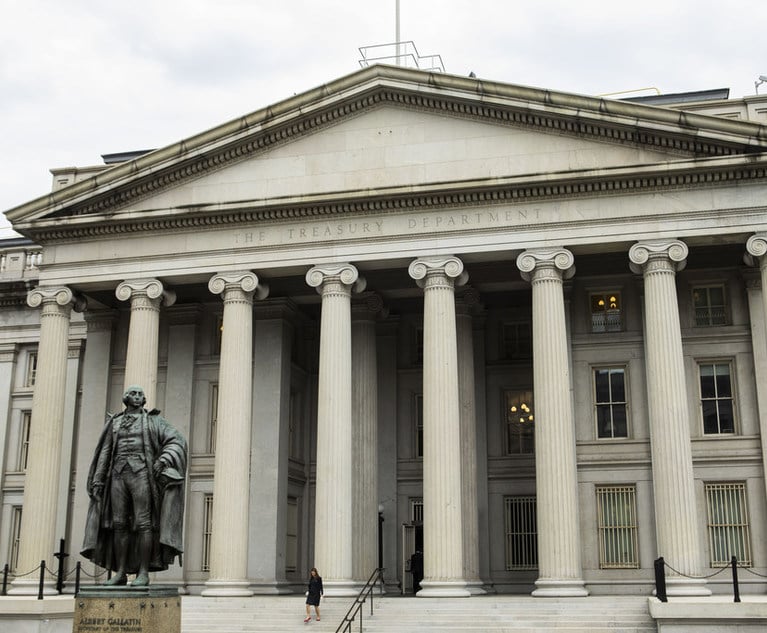Regulatory: The Consumer Financial Protection Bureau, President Obama take action on student loans
If you have kids who are in, about to go to, or just out of college, you probably know best that college tuition continues to skyrocket.
November 02, 2011 at 06:53 AM
5 minute read
The original version of this story was published on Law.com
This column is part of a series of articles on the new Consumer Financial Protection Bureau and the upcoming wave of regulations affecting the consumer financial industry.
If you have kids who are in, about to go to, or just out of college, you probably know best that college tuition continues to skyrocket. A public college costs about $17,000 per year; private colleges cost about $39,000 per year. Graduating seniors who borrow money to go to college will leave school with an average of about $22,000 in debt if they attended a public institution and $28,000 if they attended a private one. With an economy that continues to offer bleak employment prospects, the swelling personal financial outlay and debt load required to get a college education is, for some, beginning to look less and less like a good investment.
Overall, though, getting a bachelor's degree will typically result in improved job prospects. In 2010, the unemployment rate for individuals 25 and older with a high school diploma was just over 10 percent. The number dropped to 4.7 percent for graduates of four-year colleges.
College graduates still make more money than peers who end formal education after high school. In 2010, high school graduates had a median annual income of $32,552. College graduates with an associate's degree had a median income of $39,884 and those who obtained their bachelor's degree earned $53,976.
These statistics illustrate the chasm of prosperity potential between those who graduate from a four-year college and those who do not. This chasm has contributed to rising college tuition by giving the institutions of higher learning in this country a carrot on the end of their own stick. Indeed, college tuition has risen 538 percent in the past 30 years. Hungry high school graduates will chase the carrot by paying the increased costs, even if it means putting themselves in debt at or near a level they probably cannot repay. Total student loan debt will probably exceed $1 trillion by the end of the year and has already exceeded the national credit card debt. Tellingly, more than 40 percent of student loan borrowers who entered repayment of their loans in 2005 became delinquent or defaulted on them by 2010.
What is our government doing about this? They're putting Band-Aids on tumors.
At the end of October, President Obama announced a new federal student loan program designed to reduce payments on student loans. There are two key features of the initiative.
- The first is a loan consolidation program that allows borrowers with different types of loans (i.e., guaranteed and direct) to roll them into a single direct loan with a reduced interest rate.
- Second, the president accelerated the implementation of a program passed last year that established a ceiling on student loan payments at 10 percent of a borrower's disposable income. Originally set to go into effect in 2014, the program will begin affecting students next year, two years earlier than originally scheduled.
How about the Consumer Financial Protection Bureau? What is it doing? According to Raj Date, de facto head of the Bureau, “[t]he problem with student loans start from the moment financial aid information arrives from colleges.” As a result, the Bureau is once again trotting out its “Know Before You Owe” theme which it previously used on the Bureau's mortgage loan disclosure project. This time, the Bureau, in conjunction with the Department of Education, is looking for feedback on a form called a “financial aid shopping sheet.” Once complete, colleges and universities will, if they choose, provide the simple form to students who apply for student aid. Use of the form, which will include information such as the amount of debt the student will have on graduation as well as details on the financial aid package offered to students, will be voluntary.
Similar to Titles X and XIV of the Dodd-Frank Act, these adjustments by the president and the Bureau are designed to directly impact the borrowers. The indirect consequences, however, will land squarely on the lenders. Are simpler forms better? Are they enough? What impact will loan consolidation have on the bottom line of private student loan lenders? In a time of unprecedented animosity, do these efforts bring an unnecessary and undeserved focus on financial institutions? Do we really need to be diverting precious resources to the development of a form that no one intends to force colleges to use anyway?
Lenders are trying to meet a need. Students and their parents want to pay for the education that will provide the greatest opportunities. To accomplish this, more and more money is required as the days go by. The colleges are demanding the money; the lenders are simply supplying it. Whatever your views on regulation and the free market, you have to look at all this and just scratch your head. The problem does not start when the loan applications arrive. The “problem” starts when our institutions of higher learning – the factories that build the future of this country – set tuition.
Mr. Bishop will be presenting a webinar on how banks and other consumer financial services companies can manage the risks presented by the Bureau's new authority to protect consumers from unfair, deceptive, or abusive acts or practices (UDAAP) on Nov. 15, 2011. The event is free, but advance registration is required here: http://www.foley.com/news/event_detail.aspx?eventid=3945.
This content has been archived. It is available through our partners, LexisNexis® and Bloomberg Law.
To view this content, please continue to their sites.
Not a Lexis Subscriber?
Subscribe Now
Not a Bloomberg Law Subscriber?
Subscribe Now
NOT FOR REPRINT
© 2025 ALM Global, LLC, All Rights Reserved. Request academic re-use from www.copyright.com. All other uses, submit a request to [email protected]. For more information visit Asset & Logo Licensing.
You Might Like
View All
Internal Whistleblowing Surged Globally in 2024, So Why Were US Numbers Flat?
6 minute read
FTC Finalizes Child Online Privacy Rule Updates, But Ferguson Eyes Further Changes

Supreme Court Reinstates Corporate Disclosure Law Pending Challenge
Trending Stories
- 1New York-Based Skadden Team Joins White & Case Group in Mexico City for Citigroup Demerger
- 2No Two Wildfires Alike: Lawyers Take Different Legal Strategies in California
- 3Poop-Themed Dog Toy OK as Parody, but Still Tarnished Jack Daniel’s Brand, Court Says
- 4Meet the New President of NY's Association of Trial Court Jurists
- 5Lawyers' Phones Are Ringing: What Should Employers Do If ICE Raids Their Business?
Who Got The Work
J. Brugh Lower of Gibbons has entered an appearance for industrial equipment supplier Devco Corporation in a pending trademark infringement lawsuit. The suit, accusing the defendant of selling knock-off Graco products, was filed Dec. 18 in New Jersey District Court by Rivkin Radler on behalf of Graco Inc. and Graco Minnesota. The case, assigned to U.S. District Judge Zahid N. Quraishi, is 3:24-cv-11294, Graco Inc. et al v. Devco Corporation.
Who Got The Work
Rebecca Maller-Stein and Kent A. Yalowitz of Arnold & Porter Kaye Scholer have entered their appearances for Hanaco Venture Capital and its executives, Lior Prosor and David Frankel, in a pending securities lawsuit. The action, filed on Dec. 24 in New York Southern District Court by Zell, Aron & Co. on behalf of Goldeneye Advisors, accuses the defendants of negligently and fraudulently managing the plaintiff's $1 million investment. The case, assigned to U.S. District Judge Vernon S. Broderick, is 1:24-cv-09918, Goldeneye Advisors, LLC v. Hanaco Venture Capital, Ltd. et al.
Who Got The Work
Attorneys from A&O Shearman has stepped in as defense counsel for Toronto-Dominion Bank and other defendants in a pending securities class action. The suit, filed Dec. 11 in New York Southern District Court by Bleichmar Fonti & Auld, accuses the defendants of concealing the bank's 'pervasive' deficiencies in regards to its compliance with the Bank Secrecy Act and the quality of its anti-money laundering controls. The case, assigned to U.S. District Judge Arun Subramanian, is 1:24-cv-09445, Gonzalez v. The Toronto-Dominion Bank et al.
Who Got The Work
Crown Castle International, a Pennsylvania company providing shared communications infrastructure, has turned to Luke D. Wolf of Gordon Rees Scully Mansukhani to fend off a pending breach-of-contract lawsuit. The court action, filed Nov. 25 in Michigan Eastern District Court by Hooper Hathaway PC on behalf of The Town Residences LLC, accuses Crown Castle of failing to transfer approximately $30,000 in utility payments from T-Mobile in breach of a roof-top lease and assignment agreement. The case, assigned to U.S. District Judge Susan K. Declercq, is 2:24-cv-13131, The Town Residences LLC v. T-Mobile US, Inc. et al.
Who Got The Work
Wilfred P. Coronato and Daniel M. Schwartz of McCarter & English have stepped in as defense counsel to Electrolux Home Products Inc. in a pending product liability lawsuit. The court action, filed Nov. 26 in New York Eastern District Court by Poulos Lopiccolo PC and Nagel Rice LLP on behalf of David Stern, alleges that the defendant's refrigerators’ drawers and shelving repeatedly break and fall apart within months after purchase. The case, assigned to U.S. District Judge Joan M. Azrack, is 2:24-cv-08204, Stern v. Electrolux Home Products, Inc.
Featured Firms
Law Offices of Gary Martin Hays & Associates, P.C.
(470) 294-1674
Law Offices of Mark E. Salomone
(857) 444-6468
Smith & Hassler
(713) 739-1250







